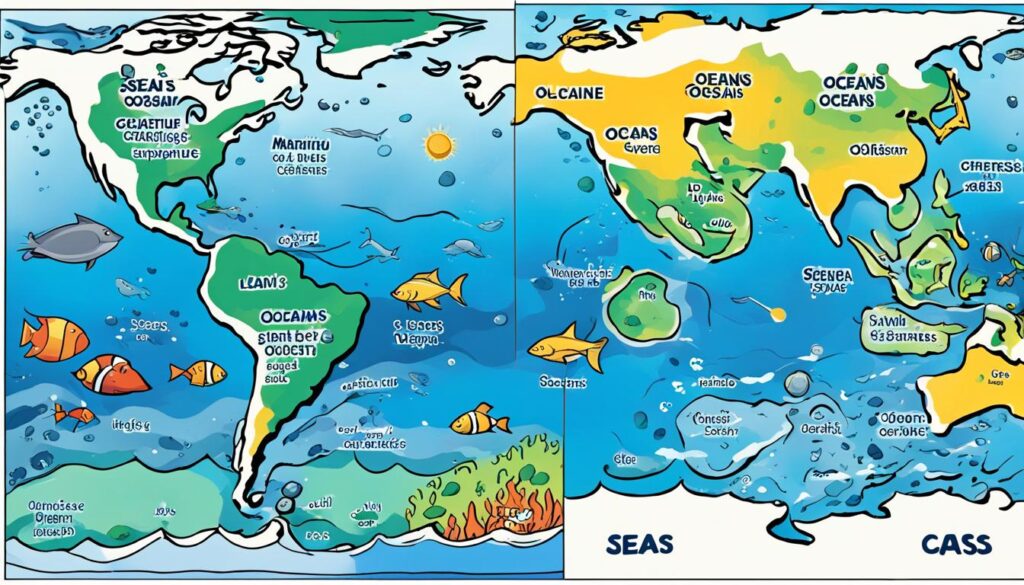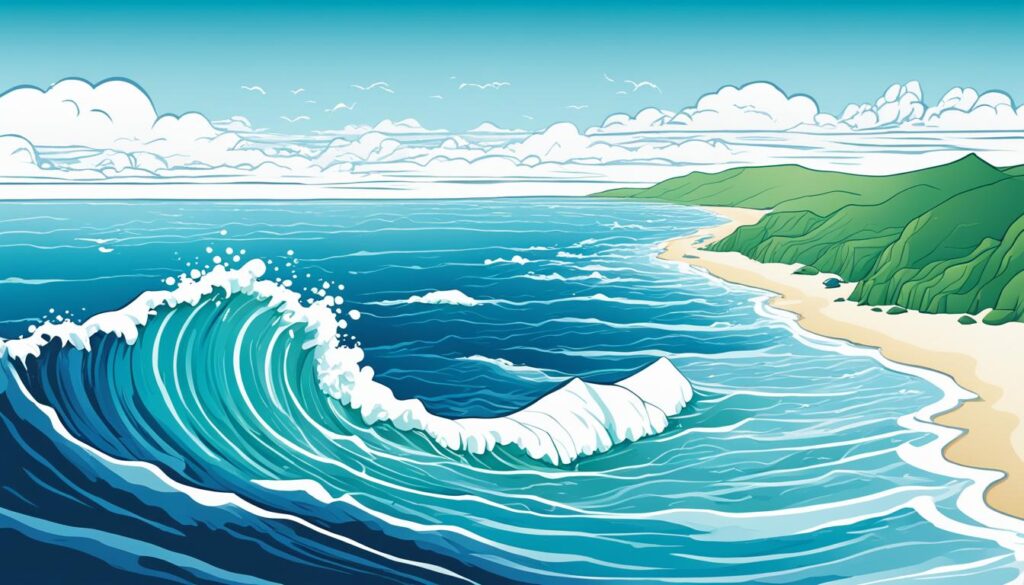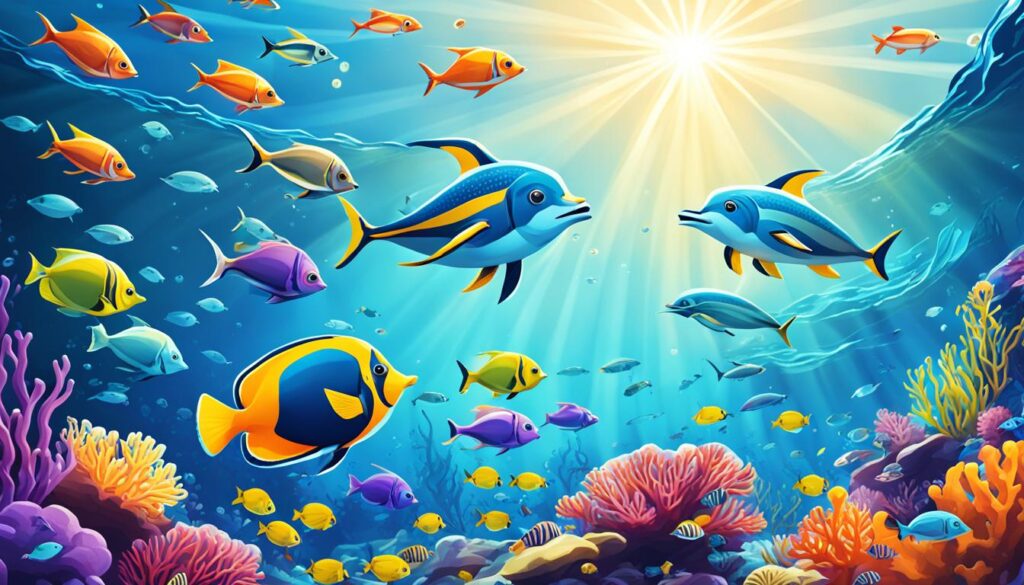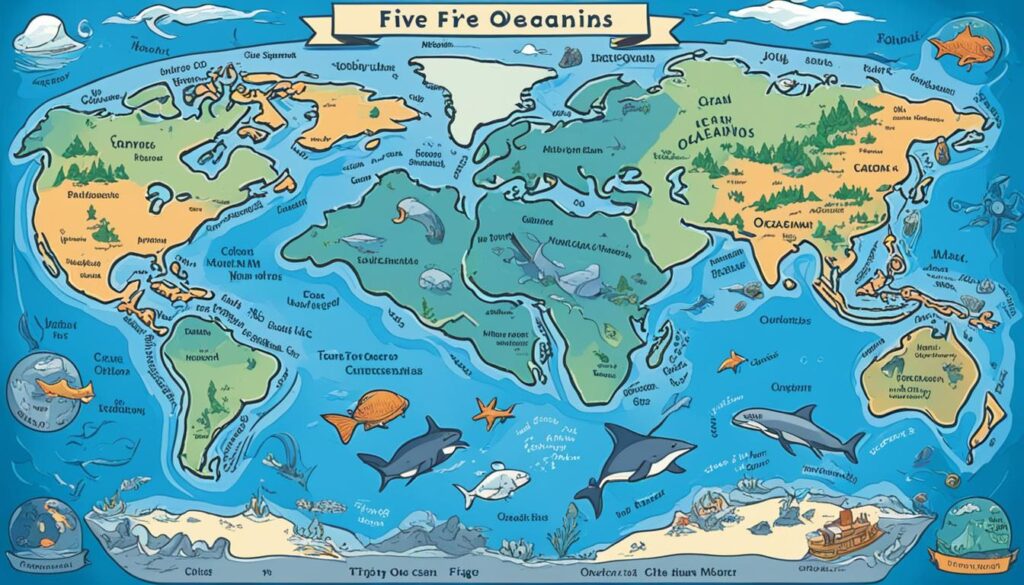Observing Earth from space, the dominant blue hue is unmistakable, signaling the vast aquatic realms that envelop our planet. Seas and oceans, holding an overwhelming 97% of all Earth’s water and covering approximately 71% of its surface, hint at their immense scale and importance. In this grand expanse, subtle yet profound differences exist between seas and oceans. Delving into the sea-ocean comparison, we embark on a journey to grasp the enormity of these waters and their pivotal role in shaping Earth’s ecology and our existence. Unearthing the distinction between seas and oceans propels us toward a greater understanding of the aquatic world and the terminology that defines it.
The nuances differentiating seas from oceans extend beyond mere size, celebrating the diversity inherent in nature. The vast Pacific Ocean, claiming nearly 30% of Earth’s surface, contrasts starkly with the more modest Aegean Sea, which sprawls over 214,000 km². Each water body boasts unique attributes, stories, and contributions to the planet’s geo-cultural fabric. Embarking on this marine odyssey to decipher ocean vs. sea distinctions enlightens us about the wide variety in global waters.
Key Takeaways
- Discover why the oceans and seas, encompassing most of Earth’s water, are vital for planetary health.
- Explore the seas vs oceans debate, clarifying their distinct geographical and ecological roles.
- Learn about the differences between seas and oceans, including size, location, and interaction with land.
- Gain insights into naming conventions reflecting cultural and historical perspectives when comparing seas and oceans.
- Uncover how the intricate distinction between seas and oceans influences marine biodiversity and human culture.
Understanding Seas and Oceans
Dive into the essence of oceanography and unveil the critical roles of Earth’s significant waterscapes. The vast networks forming our aquatic environments undoubtedly function as the planet’s dynamo, driving intricate eco-geographical processes. Seas and oceans, possessing approximately 97% of Earth’s water, are pivotal elements in our natural world. Comprehending the characteristics of seas and oceans transcends merely acknowledging their size or volume; it involves recognizing their influence on life, climate, and continental formations.
Defining the Ocean: A Vast Body of Saltwater
The sheer scale of oceanic phenomena is immense. Occupying about 72% of Earth’s surface, these saltwater ecosystems emerge as the planet’s most significant life-sustaining systems. Delving into marine biology within these domains, one discovers an astonishing spectrum of life, ranging from minuscule plankton to the colossal blue whale. The Pacific Ocean, covering almost 30% of our planet, is a profound testament to the ocean’s geographical might.
Seas: Oceanic Subdivisions Bounded by Land
Seas offer a fascinating contrast to their oceanic counterparts by exploring the interaction between land and water. Found where the ocean meets the coast, seas are marked by their partial land enclosure, which significantly influences the geographical features of seas and oceans. This dynamic fosters distinct coastal regions and impacts crucial factors like salinity and temperature, which are essential for their ecosystems.
- The Mediterranean Sea, spanning approximately 2.510 million km², epitomizes the essence of a sea, bustling with human activity and rich historical significance.
- The Arabian Sea, covering 3.862 million km², is vital to the economies of various fishing communities.
- Dominating an area of 2 million km², the Bering Sea is crucial for northern commerce and the environment.
Our understanding of the sea carries pragmatic implications. Many of humanity live within 200 miles of coastal regions, underscoring their global importance. Moreover, international regulations like the Law of the Sea Convention play a critical role in managing these invaluable resources, highlighting the deep connection between humanity and the sea.
| Ocean/Sea | Area (km²) | Volume (cubic km) | Significant Facts |
|---|---|---|---|
| Pacific Ocean | 165,250,000 | N/A | Largest and deepest ocean basin, pivotal in climate regulation. |
| Atlantic Ocean | 85,133,000 | N/A | It hosts the world’s second-largest water body, essential for global navigation. |
| Indian Ocean | 68,556,000 | N/A | Renowned as the warmest ocean, crucial for equatorial marine biodiversity. |
| Arctic Ocean | 14,056,000 | N/A | It sustains unique arctic life, recognized as the smallest and shallowest ocean basin. |
| Southern Ocean | 21,960,000 | 71,800,000 | Facilitates Antarctic water circulation, significantly affecting global sea levels. |
| Mediterranean Sea | 2,510,000 | N/A | Indispensable for global commerce and cultural interactions. |
Advancing marine and ocean literacy remains a continuous endeavor. Initiatives like the UN Decade of Ocean Science for Sustainable Development serve to expand our comprehension and guardianship of these expansive aquatic environments. As the 21st century progresses, unraveling the mysteries and maintaining the balance of these complex ecosystems becomes a paramount collective challenge.
Seas vs Oceans: Navigating the Differences
In contemplating the contrast between seas and oceans, the defining attributes distinguishing these aquatic expanses are paramount. The dichotomy presented in the ocean vs. sea comparison hinges predominantly on their dimensions and their geographical interfaces with Terra firma. C vast and boundless oceans cover approximately 71% of the Earth’s surface, presenting a stark contrast to seas. Seas manifest as comparatively diminutive and are frequently encapsulated, at least partially, by land.
The discourse surrounding the sea versus ocean contrast further diverges when considering their proximity to human settlements. Seas have historically served as vital conduits for trade and cultural dissemination, their nomenclature often reflecting adjacent regions’ cultural or geopolitical characteristics.
Despite the clear distinctions between oceans and seas, a seamless, natural continuum exists at their juncture, blurring the definitional boundaries. This amalgamation exemplifies the complexity inherent within aquatic ecosystems and highlights the challenges in comprehending their mutual influences.

Oceans command an impressive presence on our planet, with over 80% of their vastness yet to be mapped and an average depth reaching 3,720 meters. In contrast, seas present as more navigable, their shallowness lending itself more readily to exploration and scientific inquiry. Nonetheless, both face significant environmental challenges, from escalating sea temperatures to pervasive pollution threats.
The work of innovators like Marcello Calisti, who developed an underwater exploration apparatus inspired by octopodal locomotion, heralds advancements in our understanding of these largely uncharted domains. The disparity between oceans and seas extends beyond mere physical characteristics; they are vibrant bastions of biodiversity. The ocean’s breadth alone encompasses over 226,000 documented species, specifying millions more lurking undiscovered.
| Ocean | Sea |
|---|---|
| It covers approximately 71% of Earth’s surface | Smaller in comparison, often enclosed by land |
| Divided into four main regions | Directly connected to oceans with subregional influence |
| It contains around 97% of the world’s water | Hosting coastal and marginal water bodies |
| 80% remains unexplored | More mapped due to proximity to land and lower depth |
| The average depth of 3,720 meters | Generally shallower with variable depths |
| Challenges include deep-sea exploration and environmental protection | Faces threats from human activities such as pollution |
Characteristics of Seas
The discourse on sea vs. ocean typically initiates with recognizing their sizes and how they relate to adjacent land. In delineating marine environments seas and oceans, it becomes evident that seas are inherently smaller than oceans and mostly surrounded by land, significantly affecting their ecological characteristics.
Size and Enclosure by Land
The distinction between seas and oceans is pronounced, not just in size but also through the distinct geographical features they demonstrate. The discussion on seas vs. ocean size becomes insightful when acknowledging that expansive and extensive oceans contain roughly 321 million cubic miles of our planet’s water. This represents about 97 percent of all Earth’s water resources. Conversely, seas are frequently bounded by land, influencing their relationships with proximate ecosystems.
The Unique Case of the Sargasso Sea
The Sargasso Sea’s uniqueness, however, defies traditional boundaries set by land. It’s characterized not by the surrounding coasts but by ocean currents that define its parameters. Situated within the expansive Atlantic, the Sargasso Sea deviates from customary classification, introducing intriguing facts about seas vs oceans.
A comparison of certain statistics between seas and oceans is provided below:
| Attribute | Seas | Oceans |
|---|---|---|
| Size | Smaller, often enclosed by land | Larger, open water systems |
| Salinity | Varies due to land proximity | Approximately 3.5% dissolved salt |
| Oxygen Production | Varied, affected by ecosystem health | Phytoplankton produce about half of the world’s oxygen |
| Exploration | Differently explored due to accessibility | Over 80% remains unmapped and unexplored |
| Temperature Records | Different seas report varied records | Oceans hit the hottest year on record in 2018 |
| Currents | Currents can be unique to specific seas | The Atlantic’s currents have slowed by approximately 15% |
In summary, the Sargasso Sea’s exceptional features highlight the diversity within marine environments, seas, and oceans. Each possesses unique complexities and ecological importance, which are vital for comprehending our planet’s hydrosphere.
Characteristics of Oceans
Vast expanses of the major seas and oceans span our planet and constitute the lifeblood of Earth’s complex ecosystem. Encompassing a remarkable 71% of the Earth’s surface, they encapsulate approximately 97% of its water. To grasp the significance of maritime environments and their contribution to marine biodiversity, an exploration into these water bodies’ depths and breadths is essential.
Vastness and Depth: Exploration of the Major Oceans
The Pacific Ocean emerges as the epitome of vastness, covering nearly 30% of the Earth’s surface. It houses the Mariana Trench, wherein the Challenger Deep descends over 36,000 feet below sea level. The Indian Ocean, with its expansive 70,560,000 sq km (27,240,000 sq mi), holds 19.8% of the Earth’s water. Meanwhile, the Arctic Ocean, with a substantial 14,056,000 sq km (5,427,000 sq mi), and the Southern Ocean, encircling the Antarctic continent over an area of 21,960,000 sq km (8,479,000 sq mi), showcase the polar extents of oceanic vastness.

Essential Oceanic Features and Their Importance
The discourse on sea vs. ocean depth transcends physical dimensions, highlighting their indispensable roles. Far from being vast pools of saline water, they are complex marine vs. maritime environments, nurturing diverse life forms while modulating global climatic patterns. Exploring ocean and sea facts unravels their crucial position in Earth’s climate system, effectuating temperature regulations across offshore and inland areas. Although substantial, the query of bigger seas or oceans finds its answer in comparisons such as the Mediterranean, Philippine, and Coral Seas remains significantly smaller than any ocean basin.
As infinite sanctuaries, oceans act as majestic rotative conductors in Earth’s hydrospheric and atmospheric orchestra, supporting a vast spectrum of life. The differentiation between oceanic and marine ecosystems underscores that every water droplet, from superficial tide pools to the profound abyssal plains, plays a crucial role in global oceanic health.
Identifying the World’s Major Seas and Oceans
The distinction between seas and oceans becomes distinct when we explore the extent and profundity of the aquatic realms enveloping our globe. Comprehensive analyses have refined this distinction, shedding light on their diverse characteristics. This differentiation isn’t merely academic; it bears significant economic implications. For instance, the global fishing industry injects approximately $233 billion into the economy annually.
Their size and depth highlight the stark contrast between these bodies of water. For example, the vast Pacific Ocean encompasses 60,060,700 sq. mi and boasts an average depth of 13,215 ft. The Arctic Ocean, albeit sizable, spans only 5,440,000 sq. mi. Moreover, the immense depths of the Atlantic Ocean extending to 30,246 ft., showcasing the profound abysses that define our planet’s marine landscape.
Analysis reveals that Earth’s oceans and seas cover roughly 71 percent of its surface, with oceans containing 96.5% of all water. These statistics highlight the disparity between the volumes of seawater and freshwater; the latter constitutes a meager 0.036 percent of total water confined within lakes and streams. This stark contrast underscores the vastness of the ocean’s reservoir.
Data succinctly captures the distinguishing features of each major ocean. This information facilitates a deeper understanding of oceanic dimensions and underscores the diversity inherent to Earth’s aquatic environments.
| Ocean | Area (sq. mi) | Average Depth (ft.) | Greatest Known Depth (ft.) |
|---|---|---|---|
| Arctic Ocean | 5,440,000 | 3,953 | 18,456 |
| Atlantic Ocean | 29,637,900 | 12,880 | 30,246 |
| Indian Ocean | 26,469,500 | 13,002 | 24,460 |
| Pacific Ocean | 60,060,700 | 13,215 | 36,198 |
| Southern Ocean | 7,848,300 | 10,728 | 23,736 |
While seas collectively occupy less area than oceans, their ecological significance is paramount. Due to their closer proximity to land, seas are more susceptible to anthropogenic influences. They are pivotal in marine trade, bolstering local economies and communities. It’s estimated that seas may provide habitat for approximately a quarter of all eukaryotic species globally.
The terminology distinguishing seas from oceans elucidates fundamental differences in these aquatic realms. From the expansive, deep ocean basins to the more contained, shallower seas, understanding these distinctions enriches our appreciation of their roles in Earth’s hydrological cycles and marine ecosystems.
Examining Seas: Geographical Features and Marine Life
The nuanced interplay between terrestrial and aquatic realms reveals a complex array of geographical and biological phenomena integral to the distinction between seas and ocean ecosystems. Proximity to landmasses causes notable differences in the constitution of sea and ocean water, where salinity and temperature variances significantly influence. Such disparities are pivotal in defining the divergent seas vs oceans marine life, thus affecting ecosystems’ vitality and functionality.

The Role of Salinity and Temperature in Seas
Seas engage in a unique exchange with terrestrial freshwater sources, notably rivers and subaquatic springs. This interaction modulates salinity levels, engendering distinct ecological pockets that underscore the sea’s ocean contrast in biodiversity. With escalating greenhouse gas emissions, projections suggest a plausible escalation of coastal water temperatures by more than 1°C. Such thermal alteration poses survival challenges yet may also create niches for certain species, thereby recalibrating the biodiversity dynamics.
Major Seas and Their Ecosystems
The Philippine Sea and the Coral Sea, among others, maintain ecological equilibriums reflective of their respective climatic and geographical contexts. Climate-induced sea-level fluctuations and precipitation variability shape these vast waters’ ecosystems, like the American Mediterranean Sea. The resilience and adaptive capacities of the resident seas vs ocean wildlife are crucial in navigating these shifting conditions.
Insights from initiatives like NIWA’s R/V Tangaroa expedition have been instrumental in deepening our grasp of oceanic processes. Examining deep-sea water samples and temperature metrics collected from depths reaching 6,000 meters demonstrate how thermal changes in deep western boundary currents are hastening global sea-level ascension. This phenomenon presents considerable implications for both marine ecosystems and human coastal communities.
| Statistic | Impact on Marine Life | Geographical Area Influenced |
|---|---|---|
| Temperature increases >1°C | Altered species distribution | Coastal Waters |
| Sea level rise | Erosion of shores, habitat loss | Coastal Lands |
| Climate-related precipitation change | Impact on estuarine ecosystems | Coastal and Estuarine Areas |
| Ocean circulation alteration | Changes in regional temperatures | Ocean and Land Intersections |
Collaborative initiatives by entities like Scripps Oceanography, through deploying Deep Argo floats and conducting exhaustive oceanographic surveys, significantly enrich our comprehension of seas vs ocean ecosystems. These endeavors furnish crucial insights for devising robust conservation and management methodologies going forward.
Ocean Geography: Understanding the Five Oceans
In oceanography, comprehending the distinction between sea and ocean definition is critical for appreciating our planet’s vast aquatic expanses. The Earth’s surface, approximately 71% covered by oceans, is critical for maintaining marine biological equilibrium and global climate. These vast bodies of water, characterized by their diversity, play a pivotal role in regulating sea and ocean levels.

Dimensions and Unique Traits of Each Ocean
The vast size and distinctive geographical attributes of the oceans significantly contribute to Earth’s biodiversity. The Pacific Ocean, recognized as the most expansive and profound, spans about 60 million square miles with depths averaging 4,028 meters. Conversely, the Arctic Ocean, known for its icy conditions, ranks as the most diminutive and shallow, solidifying its unique ecological niche within the global oceans.
How Oceans Support Diverse Marine Environments
The study of oceanography extends beyond mapping these vast waters, delving into how they sustain a rich diversity of marine life. Within marine biology, oceans are indispensable, producing over half of Earth’s oxygen and absorbing 50 times more carbon than our atmosphere contains. These dynamics are crucial for regulating global weather patterns and fostering diverse aquatic environments through equatorial heat distribution.
Table: Ocean Characteristics and Their Global Impact
| Ocean | Avg. Depth (meters) | Area (square miles) | Notable Features |
|---|---|---|---|
| Pacific Ocean | 4,028 | 60 million | Largest and deepest, Mariana Trench |
| Atlantic Ocean | 3,646 | 41 million | Sargasso Sea, Gulf Stream |
| Indian Ocean | 3,741 | 27.2 million | Warmest ocean, Monsoon influence |
| Arctic Ocean | 1,205 | 5.4 million | Smallest and shallowest, Ice-covered |
| Southern Ocean | 3,270 | 7.8 million | Antarctic Circumpolar Current, Marine Protected Areas |
Oceanography research is vital for comprehending the world’s oceans’ interrelated nature and environmental impact. Advocating for marine protected areas and acknowledging the intricate dynamics of each ocean are steps forward in conservation. Delving into oceanography empowers us to protect these vital resources, ensuring the advancement of marine biology and the Earth’s well-being.
Marine Ecosystems in Seas and Oceans
Water encompasses approximately 71% of Earth’s surface, with oceans and seas constituting nearly 97% of the planet’s total water content. Over 230,000 identified marine species inhabit this expansive domain. The detailed analysis of seas versus oceans unveils many ecosystems, extending from shallow coastal areas to profound abyssal zones. While seas and oceans are crucial for sustaining marine ecosystems, an in-depth examination highlights significant differences and parallels in their roles in supporting marine life.
Differences are pronounced, with the Pacific Ocean’s basin making up nearly 30% of the Earth’s surface area and holding the deepest known point, the Challenger Deep in the Mariana Trench. In contrast, the Mediterranean Sea’s marine ecosystem, encompassing an area of 2.51 million km2, exhibits unique traits owing to its geographic location near human civilizations and terrestrial effects.
Every marine ecosystem, whether classified as a sea or a section of an ocean, is connected. Despite its comparatively modest area of 14,056,000 sq km (5,427,000 sq mi), the Arctic Ocean basin plays a crucial role akin to that of the Southern Ocean basin. It was recognized in 2000 for its sizable impact on global climatic patterns and its contribution to biodiversity.
The exploration into marine biodiversity reveals the complexity within. The Tasman Sea, which covers an area of 2.3 million km2, and the Philippine Sea, with its 5.695 million km2, serve as critical components of the Global Ocean’s vast ecosystem. Despite their size differences, each contributes indispensably to the equilibrium and vitality of Earth’s marine environments.
| Ocean / Sea Name | Area | Unique Features |
|---|---|---|
| Arctic Ocean | 14,056,000 sq km | Smallest and shallowest |
| Southern Ocean | 71,800,000 cubic km | Encircles Antarctica |
| Caribbean Sea | 2.754 million km2 | Lush coral reef systems |
| Indian Ocean | 70,560,000 sq km | Warmest ocean basin |
When we delve into the similarities and differences between seas and oceans, our quest transcends mere quantitative analysis; we decipher the essence of Earth’s biodiversity. This journey uncovers a complex, interconnected existence among all aquatic realms, ensuring a delicate balance that nurtures life beneath the waves and along coastal fringes.
Sea Water vs Ocean Water: A Comparative Analysis
Upon examining the similarities between seas and oceans, one discerns that profound distinctions arise despite being integral components of a unified global system, markedly influencing their ecosystems. Their commonality—comprising saltwater—belies the nuanced differences occasioned by geographical adjacency to landmasses and prevailing climatic conditions, particularly visible in salinity variations.
Analyzing Salinity and Ecosystems
Typically, salinity in seawater oscillates between 33ppt and 37ppt, with estuaries and evaporation rates being pivotal determinants. Contrastingly, regions such as the Red Sea and the Persian Gulf exhibit salinity levels around 40ppt, fostering unique marine ecosystems. These higher salinity levels are attributed to elevated evaporation rates and limited freshwater inflow.
Understanding the Effects of Land Proximity on Water Composition
The salinity and composition of seas and oceans are significantly influenced by their geographic features, particularly landforms. Proximity to land causes seas to undergo more pronounced temperature and salinity shifts compared to oceans. These fluctuations engender diverse ecosystems, illustrating the variances when conducting a sea vs. ocean comparison.
| Characteristic | Sea Water | Ocean Water |
|---|---|---|
| Salinity | 33ppt to 37ppt | The Atlantic Ocean basin averages the highest, often over 37ppt |
| Freezing Point | 17ppt at approx. 30°F (-1°C) | 35ppt at approx. 28.5°F (-2°C) |
| Salt Content in Ice | About 1/10th of seawater | Higher density, less likely to form sea ice |
| Density | Increases in salinity and lower temperature | Varies with depth and temperature |
| Polar Regions Surface Salinity | Lower in summer due to ice melt | Higher below the surface in winter due to ice formation |
The geographical positioning of seas vs oceans is crucial to their defining characteristics. Seas, sheltered by land, often receive substantial freshwater input, contributing to a plethora of habitats distinctly divergent from those in the vast oceans. This variance in salinity not only delineates their distinctiveness but also influences the deep-water currents essential for equilibrium within the global marine ecosystem.
Global Ocean Conveyor: The Link Between Seas and Oceans
The global ocean conveyor, symbolic of our planet’s aquatic marvels, constitutes the thermohaline circulation system. This intricate web is crucial in amalgamating myriad seas, delineating the essence of seas versus oceans. It’s instrumental in the dynamic interchange between oceanic and marine ecosystems, crucial for sustaining the global climate balance and nurturing the rich biodiversity in both seas and oceans.
Thermohaline Circulation and Its Implications
Investigations into the Atlantic Meridional Overturning Current (AMOC) underscore emergent concerns. A groundbreaking analysis, heralded within Nature’s pages, forewarns the AMOC’s impending destabilization, with projections indicating a potential tipping point by 2025. This impending peril, denoted by modifications in sea surface temperatures, portends significant upheavals in oceanographic levels and climatic patterns reminiscent of the stark 10 to 15 degrees Celsius swings recorded in ancient times.
Impacts on Climate and Marine Biodiversity
Anticipations of AMOC’s failure between 2039 and 2070 unveil grave climatic and biological consequences. Recollection of past epochs, defined by rapid ice melts triggering severe weather shifts, accentuates the imperative to curtail greenhouse emissions. The survival of marine ecosystems, seas vs oceans, is predicated upon immediate, resolute measures to preserve Arctic solidity and mitigate the global warming trajectory. This transcends mere environmental stewardship; it represents an existential mandate for the continuance of life across our planet’s aqueous realms.
FAQ
What are the main differences between seas and oceans?
How is an ocean defined?
What distinguishes a sea from an ocean?
What is unique about the Sargasso Sea?
Which is bigger, seas or oceans?
What are the significant seas and oceans of the world?
How do factors like salinity and temperature affect marine life in seas?
Can you give an overview of the geography of the five oceans?
Are there similarities between the marine ecosystems of seas and oceans?
How does the composition of seawater compare to ocean water?
What is the Global Ocean Conveyor, and why is it important?
How do seas and oceans influence the Earth’s climate?
Source Links
- https://oceanliteracy.unesco.org/ocean-and-seas/
- https://www.un.org/en/global-issues/oceans-and-the-law-of-the-sea
- https://www.infoplease.com/geography/oceans-and-seas
- https://www.nationalgeographic.org/encyclopedia/ocean/
- https://www.nationalgeographic.com/environment/article/ocean
- https://www.britannica.com/science/ocean
- https://www.usgs.gov/programs/cmhrp/news/top-10-things-you-didnt-know-about-ocean
- https://www.c2es.org/document/coastal-and-marine-ecosystems-global-climate-change-potential-effects-on-u-s-resources/
- https://scripps.ucsd.edu/news/exploring-ocean-currents-20000-feet-under-sea
- https://www.dictionary.com/e/ocean-vs-sea/
- https://www.geographyrealm.com/what-is-the-difference-between-a-sea-and-an-ocean/
- https://www.nationalgeographic.com/environment/article/theres-a-new-ocean-now-can-you-name-all-five-southern-ocean
- https://www.noaa.gov/jetstream/ocean/sea-water
- https://www.cnn.com/2023/07/25/world/gulf-stream-atlantic-current-collapse-climate-scn-intl/index.html
